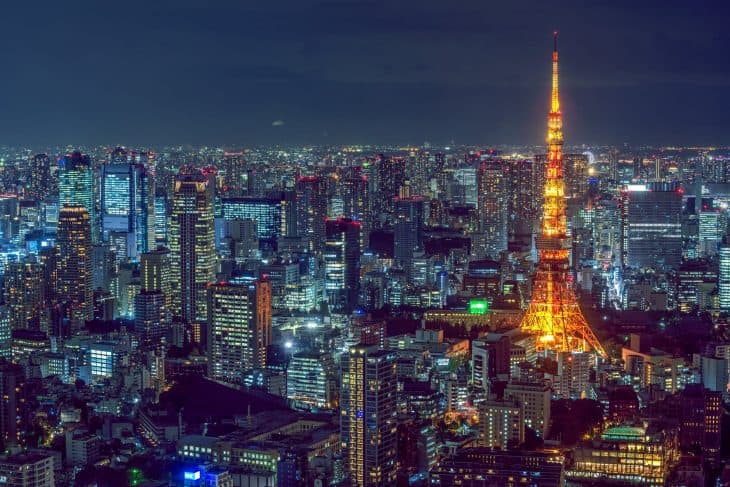
Tokyo is already glamorous on the surface. However, there is still more underneath its iconic neon lights and magnificent tourist attractions. No bombings, wars or earthquakes could break the culture and resiliency of the city. Here are 80 Tokyo facts to prove that!
- Tokyo Metropolis is the capital of Tokyo, Japan, and is also the biggest and most populous city in the region.
- Located in the southern Kanto region, Tokyo sits right in the center of the Japanese archipelago.
- Tokyo covers a total land area of 2,188 square kilometers or 845 square miles.
- The largest metropolitan area in the world is Tokyo.
- As of January 2020, Tokyo has a population of 126,647,244.
- Tokyo operates on the Japan Standard Time or JST timezone, which is GMT+9.
- By using colored lights, a skyscraper in Tokyo tells people if they should bring an umbrella when going out.
- More than 6,000 different gardens and parks cover over 1,000 hectares or 2,471 acres of Tokyo.
- The streets of Tokyo boasts of zero vandalism.
- Tokyo is also hailed as one of the safest cities in the world.
- By 2020, Tokyo is about to be the first Asian city to host the Olympic Games more than once.
- Every five years, the Tokyo Tower requires a repaint job worth around 7,500 gallons of paint.
- Takao-san, the most visited mountain in the world, is in Tokyo, along with a beer garden and an udon shop at the summit.
- The most expensive hotel room in Tokyo is the Ritz Carlton Suite priced 25,000 US dollars per night.
- From Tokyo, Mt. Fuji is only visible for only around 79 days each year.
- A manga entitled Akira (1982) predicted Tokyo’s hosting of the 2020 Olympics.
- A Tokyo travel agency is paid to take your stuffed animal on vacation without you.
- Tokyo has 2,079 7-Eleven stores, with Japan having almost twice as many stores as the U.S.
- Each Tokyo train station has a unique theme song with lines navigating through 503 stations at 23 wards.
- News of the Hiroshima bombing reached Tokyo 3 hours late.
Tokyo Facts Infographics
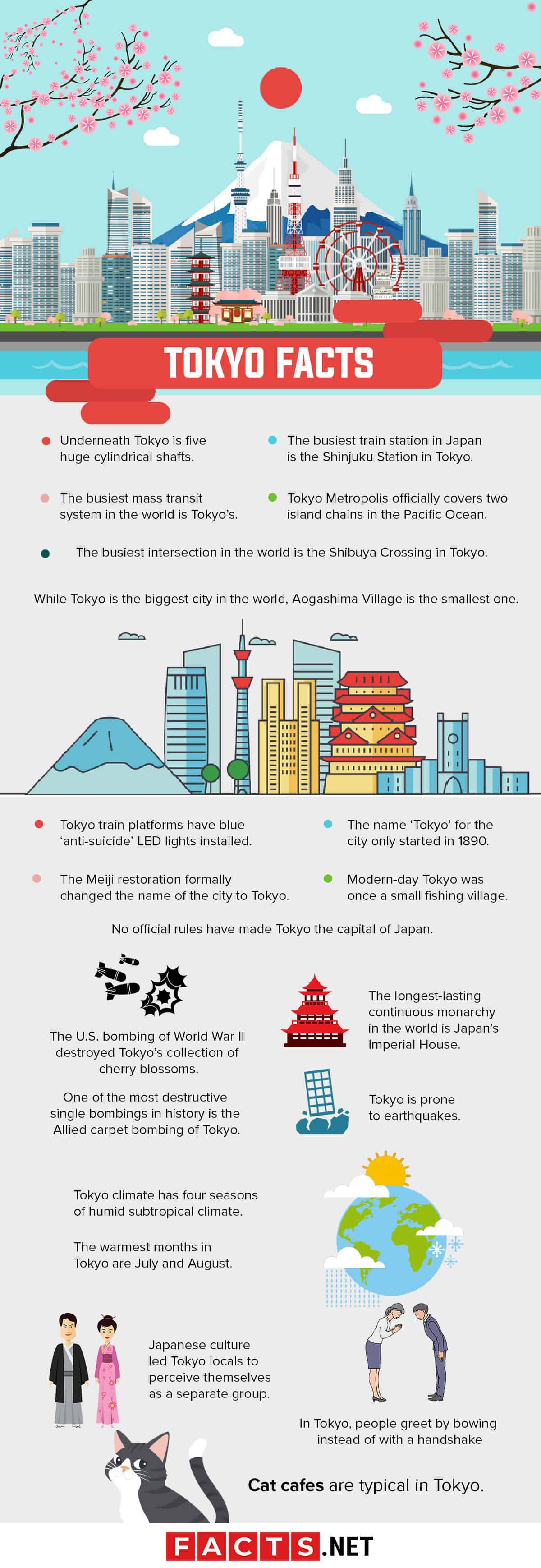
Underneath Tokyo is five huge cylindrical shafts.
Flood water would go down these cylinders during calamities, stirring clear of the path of damaging the city.
The busiest train station in Japan is the Shinjuku Station in Tokyo.
Among the 51 busiest train stations in the world, 45 are in Japan. Shinjuku Station has 36 platforms serving around 1.2 billion passengers annually. These stations include both underground and aboveground arcades, numerous hallways, and a total of 200 exits.
The busiest mass transit system in the world is Tokyo’s.
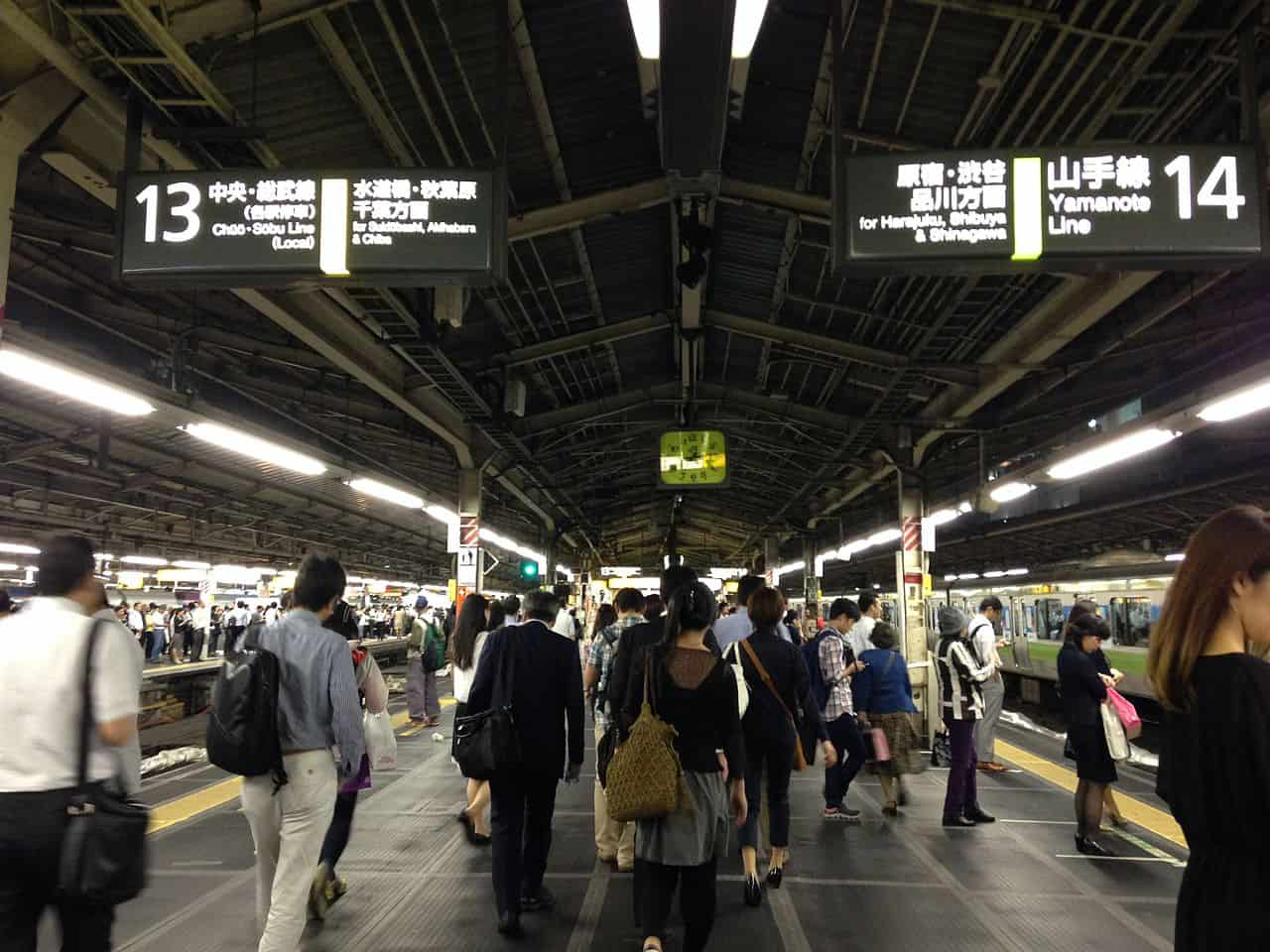
First operated in 1927, it underwent great expansions in preparation for the 1963 Summer Olympics. All 320 kilometers or 200 miles of its tracks serve at least 8.7 million commuters every day and at least 3.2 billion every year.
Tokyo Metropolis officially covers two island chains in the Pacific Ocean.
The Izu Islands and the Ogasawara Islands are apart from the mainland at over 1,000 kilometers or 620 miles. Still, they are under the administrative boundaries of Tokyo.
The busiest intersection in the world is the Shibuya Crossing in Tokyo.

With every pulsing change of traffic lights, the Shibuya Crossing sends people from all directions in all directions. More than 1000 people are said to be crossing at once at peak times
While Tokyo is the biggest city in the world, Aogashima Village is the smallest one.
Both are part of the Tokyo Prefecture. Aogashima Village, Izu Islands has a population count of only 194 and is the smallest both in Japan and in the world.
Tokyo train platforms have blue ‘anti-suicide’ LED lights installed.
They aim to reduce railway suicides that are rampant in the country. With its calming effect, the lights dropped the rates of suicides at stations to 84% since its installation.
The name ‘Tokyo’ for the city only started in 1890.
Back in the 20th century, its name was ‘Edo’ which means ‘estuary.’
Modern-day Tokyo was once a small fishing village.
The first settlers in the city date back to about 3,000 BC. In the 12th century was the first fortification of Edo, and in the 1450s, the Edo Castle took the site of what is now the Imperial Palace.
The Meiji restoration formally changed the name of the city to Tokyo.
Almost 700 years of the shogunate period ended, and the new emperor Meiji took office. ‘Tokyo’ means ‘eastern capital’.
No official rules have made Tokyo the capital of Japan.
Hence, some Kyoto locals insist that the former imperial city is the rightful titleholder.
The longest-lasting continuous monarchy in the world is Japan’s Imperial House.
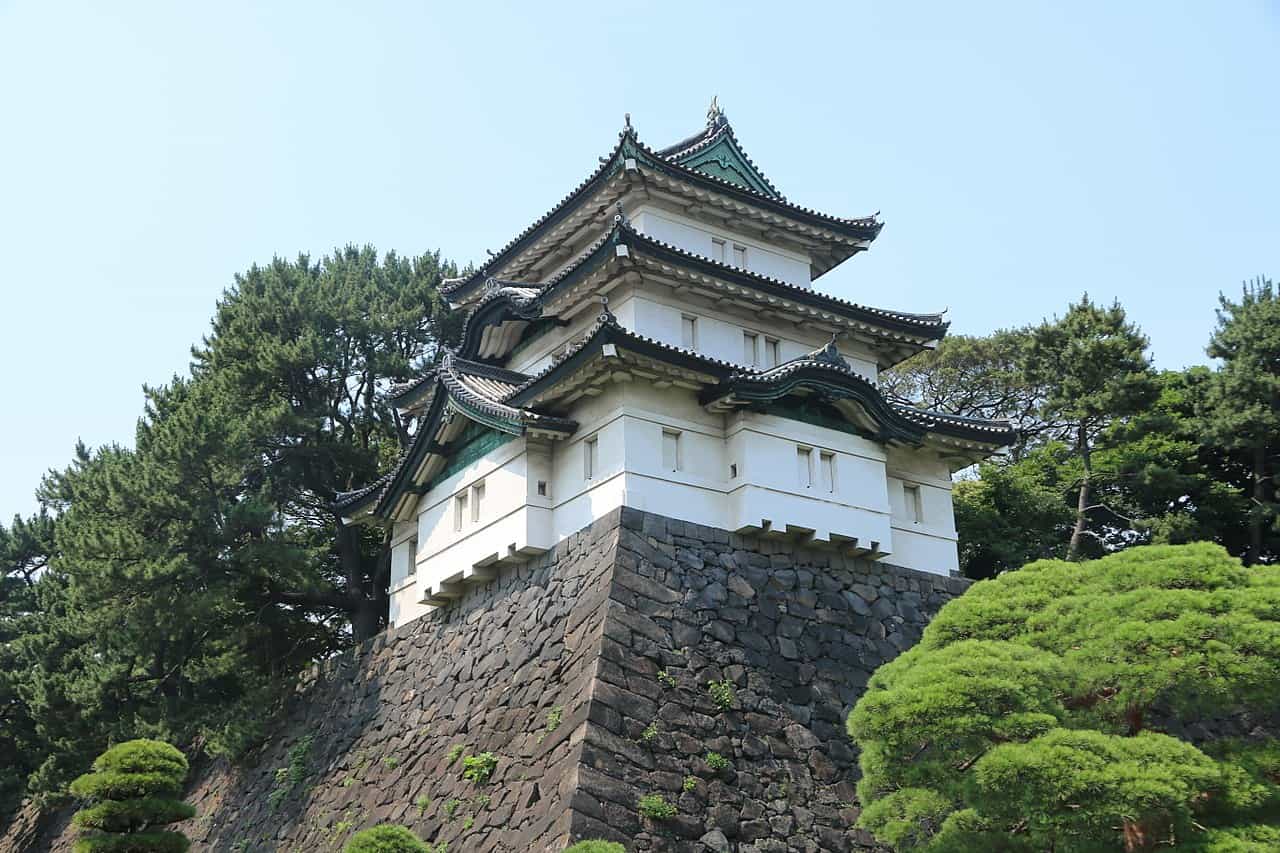
On its ‘Chrysanthemum Throne’ sat 125 monarchs since its institution around 660 BC.
One of the most destructive single bombings in history is the Allied carpet bombing of Tokyo.
Three hundred B29 bombers dropped around 500,000 cylinders of petroleum jelly and napalm. Resulting in a 40-square-kilometer firestorm, the bombing killed more people than the combined numbers of the Nagasaki and Hiroshima bombing.
The U.S. bombing of World War II destroyed Tokyo’s collection of cherry blossoms.
After the war ended, Washington DC sent cuttings from their cherry blossoms to Japan, which are originally a gift from the receiving country.
Tokyo is prone to earthquakes.
In its rebuilding operations after World War II, construction designs provided stronger protection in defense to possible major earthquakes. Extreme quakes hit Tokyo in 1703, 1782, 1812, 1855, 1923, and 2011. In the 1923 earthquake alone, around 142,000 people died.
Tokyo climate has four seasons of humid subtropical climate.
With its dry winters and rainy summers, Tokyo has consistently booming tourism for its attractions throughout the year. Spring compels cherry blossom celebrations, autumn blooms maple and ginkgo tree displays, and winter unlocks the majestic view of Mt. Fuji with a cap of snow.
The warmest months in Tokyo are July and August.
In this most humid period, temperatures rise up to 95 degrees Fahrenheit. Meanwhile, June, September, and October rank as the wettest months of the year, usually with about 7 inches of rain.
Japanese culture led Tokyo locals to perceive themselves as a separate group.
It might even make the Japanese appear aloof in Western standards, but these people could not just readily accept non-Japanese stuff. Still, this makes Japanese culture unique in its ways.
In Tokyo, people greet by bowing instead of with a handshake.
Hence, failing to return the traditional bow is a sign of rudeness. It is also impolite to count the change after a bargain. Wearing shoes are frowned upon in homes and temples while bringing a gift is a must when invited.
Cat cafes are typical in Tokyo.
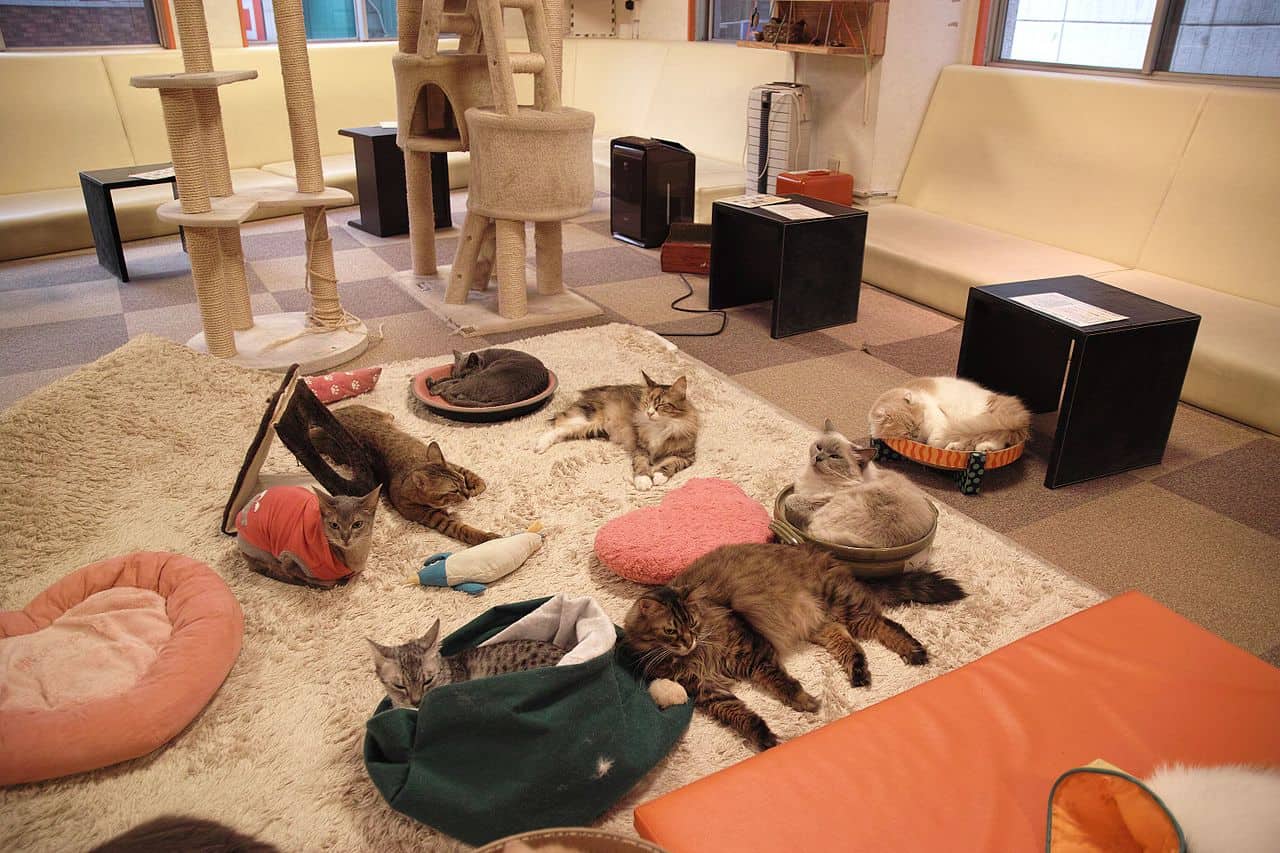
Places like this allow people to pay hourly rates to hang out with cats, especially those living in apartments or condominiums where pets are not allowed.
The city with the highest marriage rate in Japan is Tokyo.
What makes it even better is that most of the married couples stay together as well. While Tokyo only ranks 8th in the country’s highest divorce rate, Okinawa has the most marriages ending in divorce.
The cultural center of Japan is Tokyo.
Its origins could be traced back to the ethnic Jomon culture. However, influences from the Chinese, Korean, Greek, Indian, European, and American mixed in and birthed the unique culture of Japan.
Tokyo’s traditional arts reflects its unique culture.
Among these are the flower arranging or ‘ikebana,’ folding paper into object forms or ‘origami,’ woodblock printing or ‘ukiyo-e,’ complex dramas or ‘kabuki,’ restrained and stylized drama or ‘noh,’ puppet theater or ‘bunraku,’ satirical plays or ‘kyogen,’ detailed storytelling or ‘bunraku,’ hot springs as public bathing places or ‘onsen,’ and delicate tea ceremonies.
Japanese culture also counts numerous celebrations, festivals, and rituals in Tokyo.
It is New Year tradition to visit shrines, apart from the religious festivals or ‘matsuris,’ and portable shrines or ‘mikoshis,’ which are all observed in the Tokyo calendar. Meanwhile, the viewing of cherry blossoms is most prevalent in April.
Tokyo is known for its trendy fashion, music, art, animation, and technology.
As the cultural center of Japan, Tokyo is a stage for the meeting between tradition and innovation. One side of the city is all historical with its shrines and temples, and performing arts that entertained people for centuries.’ Major venues in Tokyo include the Kabukiza Theater, Kokugikan Hall, and the National Noh Theater.
Tokyo’s Harajuku has a reputation for its one-of-a-kind street fashion.

This colorful district is Japan’s ultimate center for extreme teenage style and cultures. Takeshita Dori stands as the focal point of the teenage culture in Harajuku.
The national flower of Japan is the cherry blossom.
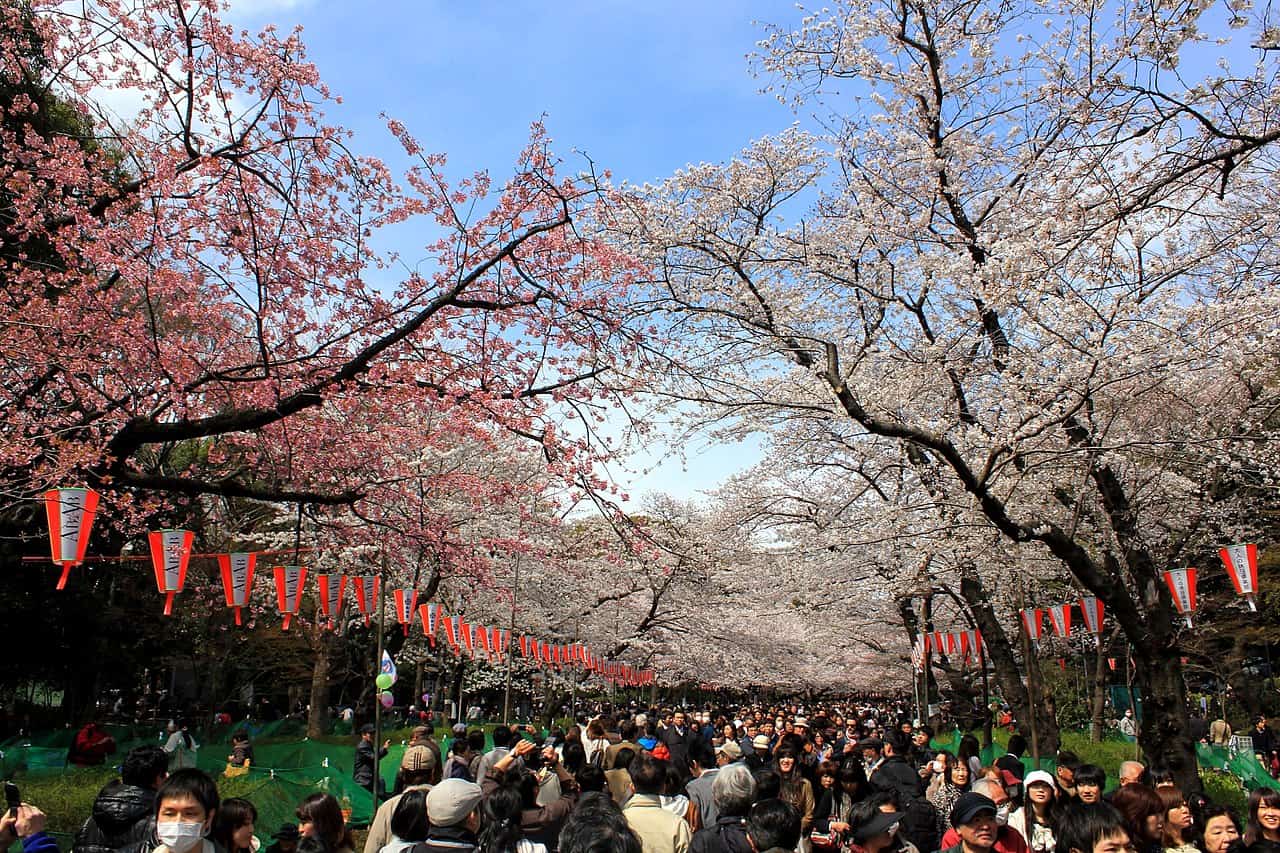
Not only does it symbolize the arrival of spring, but it also signals the beginning of the new school and financial year. Tokyo’s cherry blossom trees are one of the many reasons why tourists flock the city. In Ueno Park alone, more than 1,000 trees stand for the entertainment of guests.
The cherry blossoms are only alive for two weeks in an entire year.
A significant part of Japan’s spring is the arrival of the season of the cherry blossoms. It also indicates the ending of the region’s harsh winters.
Tokyo was the world’s ‘Capital of Gastronomy’ in 2017.
Restaurants in Tokyo have acquired more collective Michelin stars than Paris. Even the editorial director of Michelin regarded Tokyo with such title in 2017.
In Tokyo, 22 sushi restaurants received Michelin stars.
This number came from hundreds of sushi restaurants in the city with diverse price ranges.
Tokyo’s Komagata Dozeu claims to be the oldest restaurant in the city.
This eatery has been whipping poached loach since 1801, covering six generations of its owners. While other contestants eye the title, Komagata proved its durability past the earthquakes and bombing raids that shook its vicinity.
One of the most expensive restaurants in the world is Tokyo’s Aragawa.
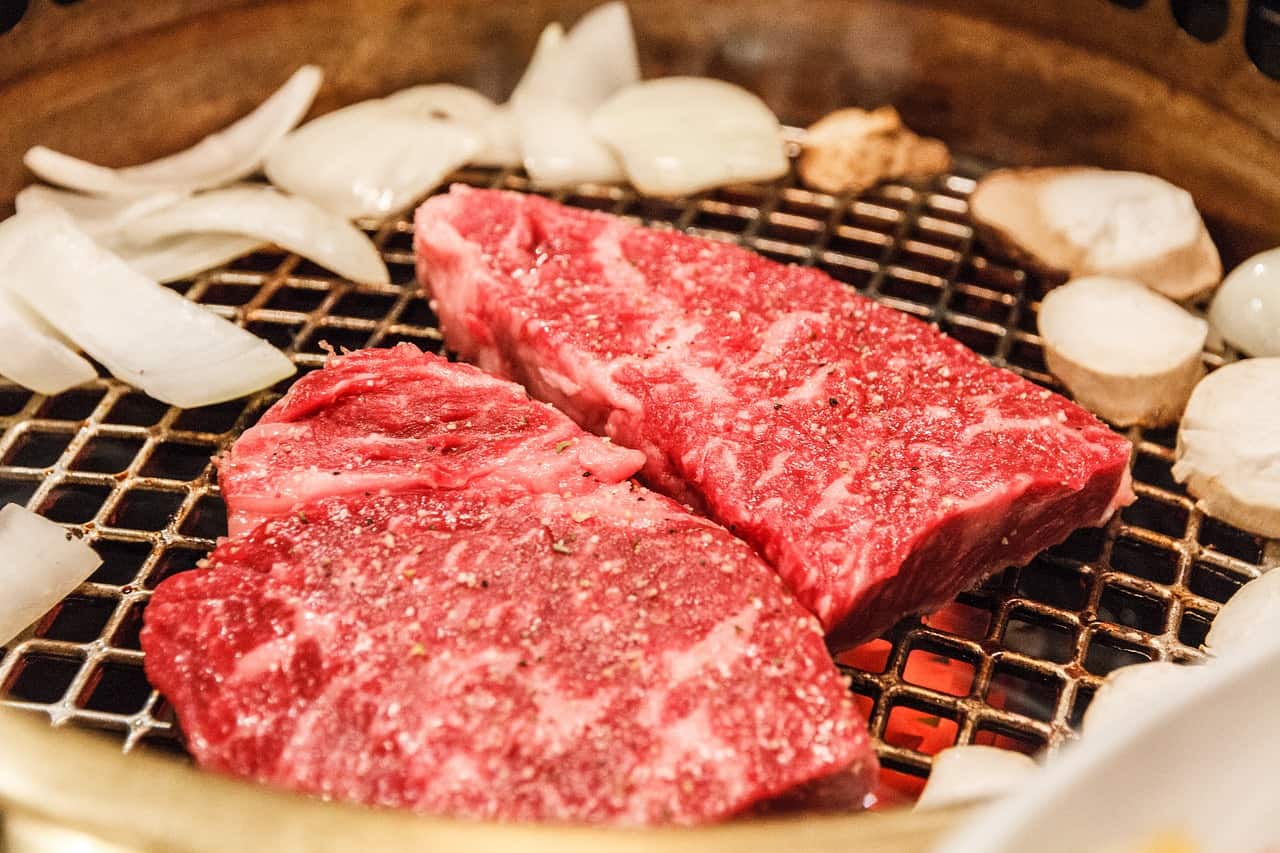
This steakhouse specializes in Kobe beef. The average cost per person is at least ¥35,000 per meal per person. Their mustard sauce is a must-try.
The Tokyo Olympics 2020 schedule is from July 24 to August 9.
For the first time, contestants would compete in karate, skateboarding, sport climbing, and surfing in the city. What makes it more interesting is that the Games would have the luxury of having Tokyo’s most iconic landmarks as their scenic backdrops.
The Tokyo Vision aims to achieve a cultural legacy for the city from the 2020 Tokyo Olympics.
The Olympics Game serves as a part of Tokyo’s long-term cultural plan for the years to come, aiming to promote Japanese culture and art all over the world.
The Tokyo Marathon is one of the six major world marathons.
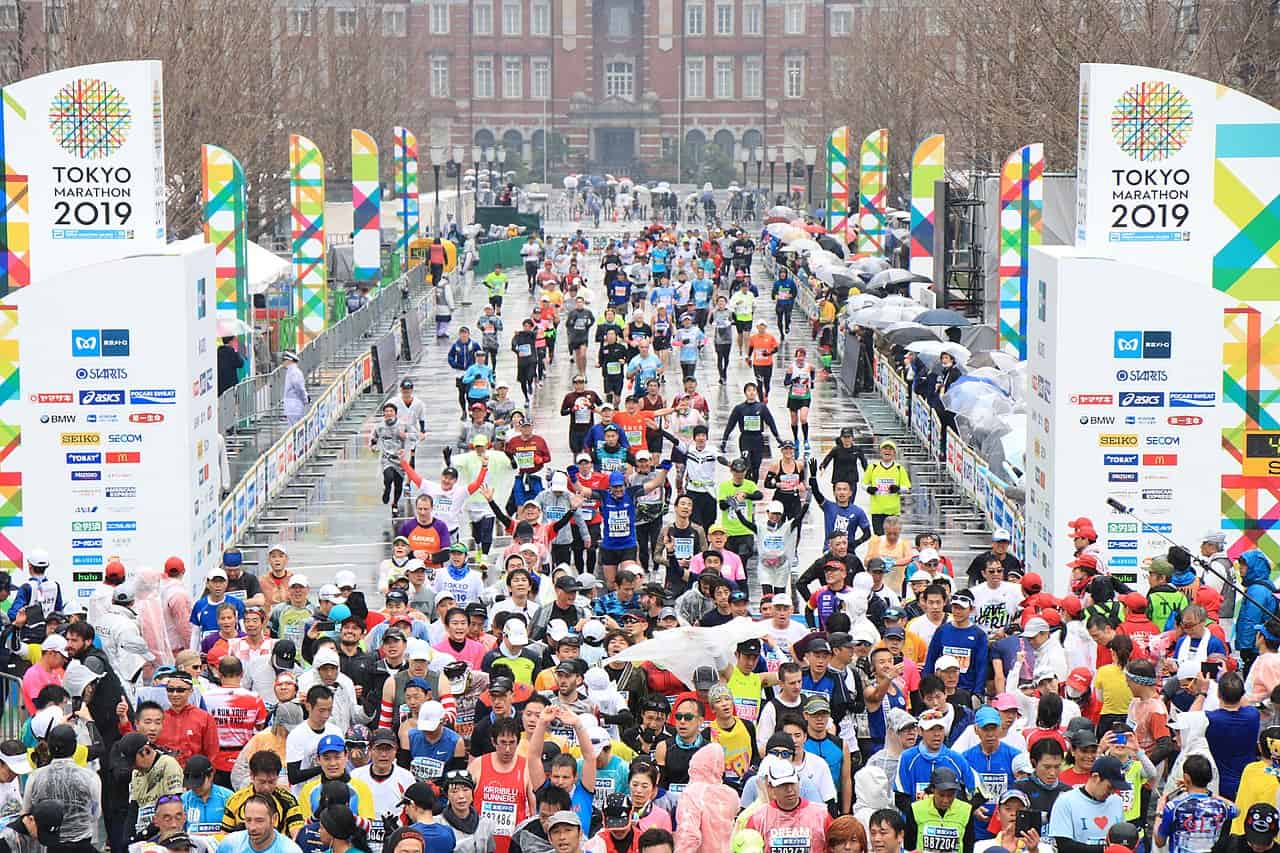
Held annually every February, the footrace gathers participants to finish the 42.2 kilometers or 26.2 miles of the race. It joins the list alongside Chicago, New York, Boston, Berlin, and London. Tokyo was the most recent to establish the major marathon in 2007, elevating to the status in 2012.
The setting of the manga and anime entitled Saint Young Men is the city of Tokyo.
It tells of the story of Jesus and Buddha taking a vacation on Earth. They live as roommates in Tokyo and attempts to understand Japanese society.
University of Tokyo researchers designed an unbeatable robot hand.
With the help of a high-speed camera, the robot can recognize, within 1 millisecond, which shape a human hand is about to make. This feature enables it to produce the corresponding winning shape in a game of rock-paper-scissors, ensuring a 100% winning rate.
Tokyo Disneyland was the first Disney park built outside the U.S.
This theme park stands at the Tokyo Disney Resort located in Urayasu, Chiba just nearby Tokyo. It is also one of the only five Disney Resorts in the world.
The world’s tallest free-standing tower is the Tokyo Sky Tree.
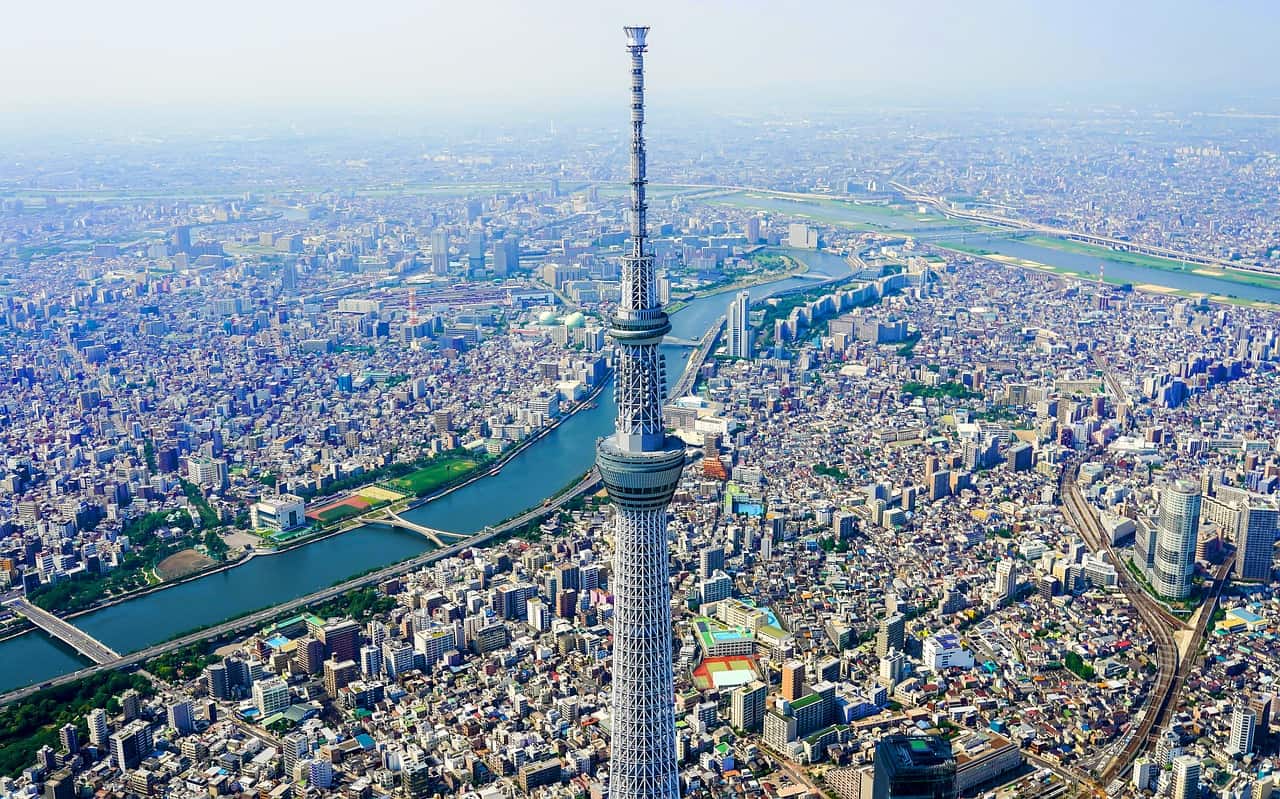
It stands at a height of 634 meters for ‘Murashi’, which they chose simply because of wordplay. Although, several numbers with alternate meanings also took part in the choices.
The Tokyo Tower is the second-tallest structure in Japan, following right after the Tokyo Skytree.
As communication and observation tower in Tokyo, Japan, the Tokyo Tower holds the master control over the Tokyo metropolitan area. Under its authority are the television broadcast signals, FM radio reception and transmission, traffic information transmission, and weather and air pollution data collection.
In compliance with air safety regulations, the Tokyo Tower was painted white and orange.

It once took the Tallest Freestanding Tower title from the Eiffel Tower on October 14, 1958, when a 90-meter or 295-foot antenna added to its total height.
The Imperial Palace, a tourist attraction in Tokyo, served as the main residence of the Emperor of Japan.
This spacious park-like area in Tokyo’s Chiyoda ward is complete with the main palace, private residences for the Imperial Family, museums, an archive, and administrative offices. Public outer gardens allow guests to stroll through green parks and see the cherry trees surrounding the water-filled moat.
The busiest shopping area in Tokyo is Ginza.
While it might be as iconic as New York Times Square, Ginza is much older. It has served as the country’s commercial center for centuries, standing on the joint where five ancient roads connected Japan’s major cities. Exclusive shops with grand facades and various coffee and tea shops line this district.
The largest and busiest fish market in the world is the Tsukiji Market.

Over 400 different types of seafood pass this market’s trade. Whether it is cheap seaweed or expensive caviar, tiny sardines or huge tunas, The Tsukiji Market might as well have it all. Live tuna auctions take place every 5 in the morning.
Almost every street in Tokyo has a haunted house.
However, experts say that the best ghost hunting spot in Tokyo is the Komine Tunnel in Hachioji. Stories of a girl in a red dress spread alongside the frequency of traffic accidents transpiring in the area.
The Nakagin Capsule Tower, a building true to its name, was built in Tokyo in 1972.
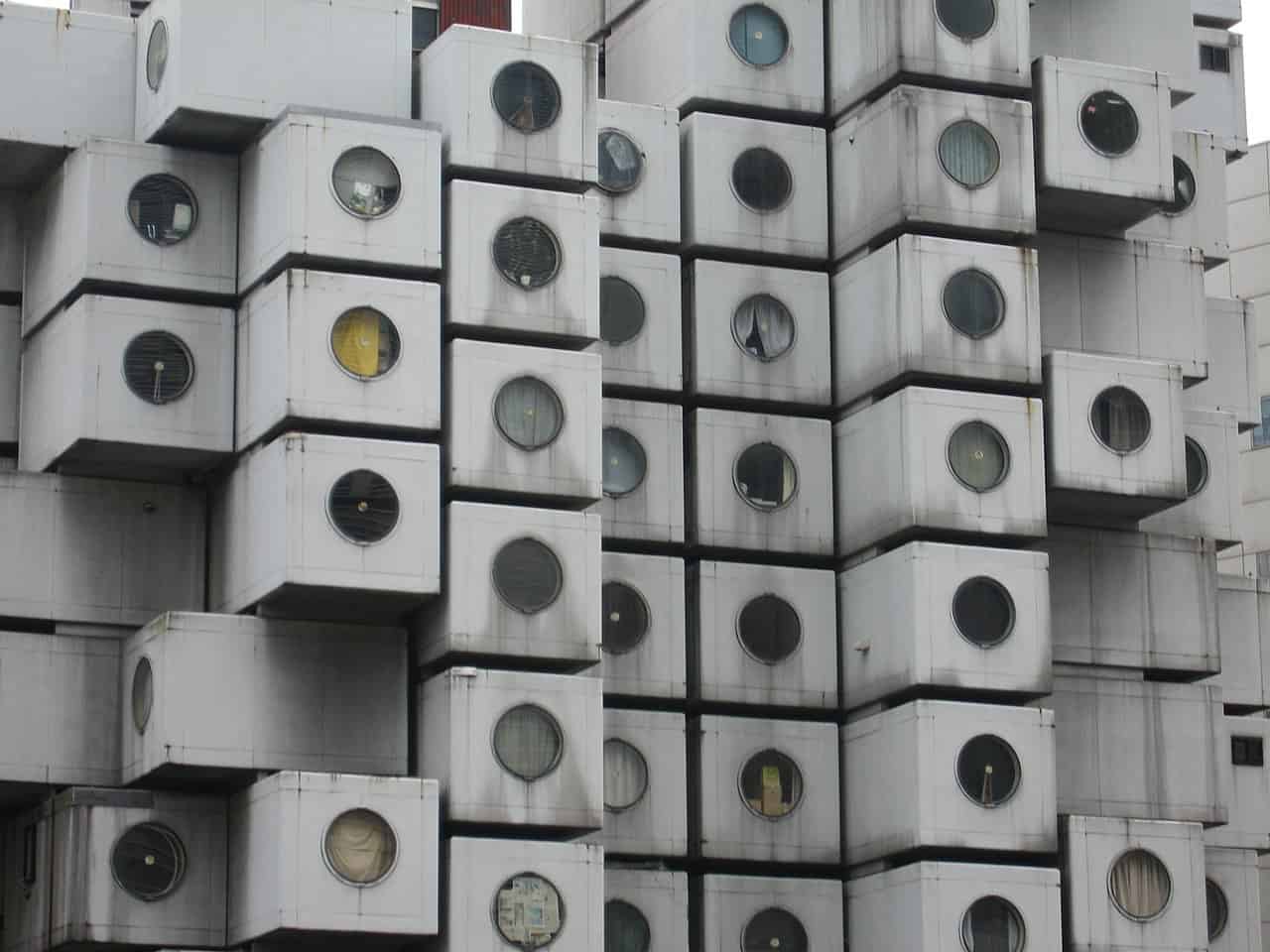
Rooms called ‘capsule apartments’ in this building are only 90 square feet and are individual in a way that they could undergo replacements similar to lego pieces.
The largest paper store in Japan is Itoya.
It is a 12-story paper store where each floor offers a different category of products. The 11th floor is an indoor organic farm, while the 12th floor is a cafe where they serve salad grown from the level right below.
Butler’s Cafe in Tokyo is the only cafe that only hires men as staff.
The owner thought that Japanese women wanted an all-male-waiters cafe where all of them are good-looking, nice, and, most importantly, Western. This notion inspired the owner to start the butler-themed cafe.
Tokyo has the most number of neon signs over all the cities in the world.
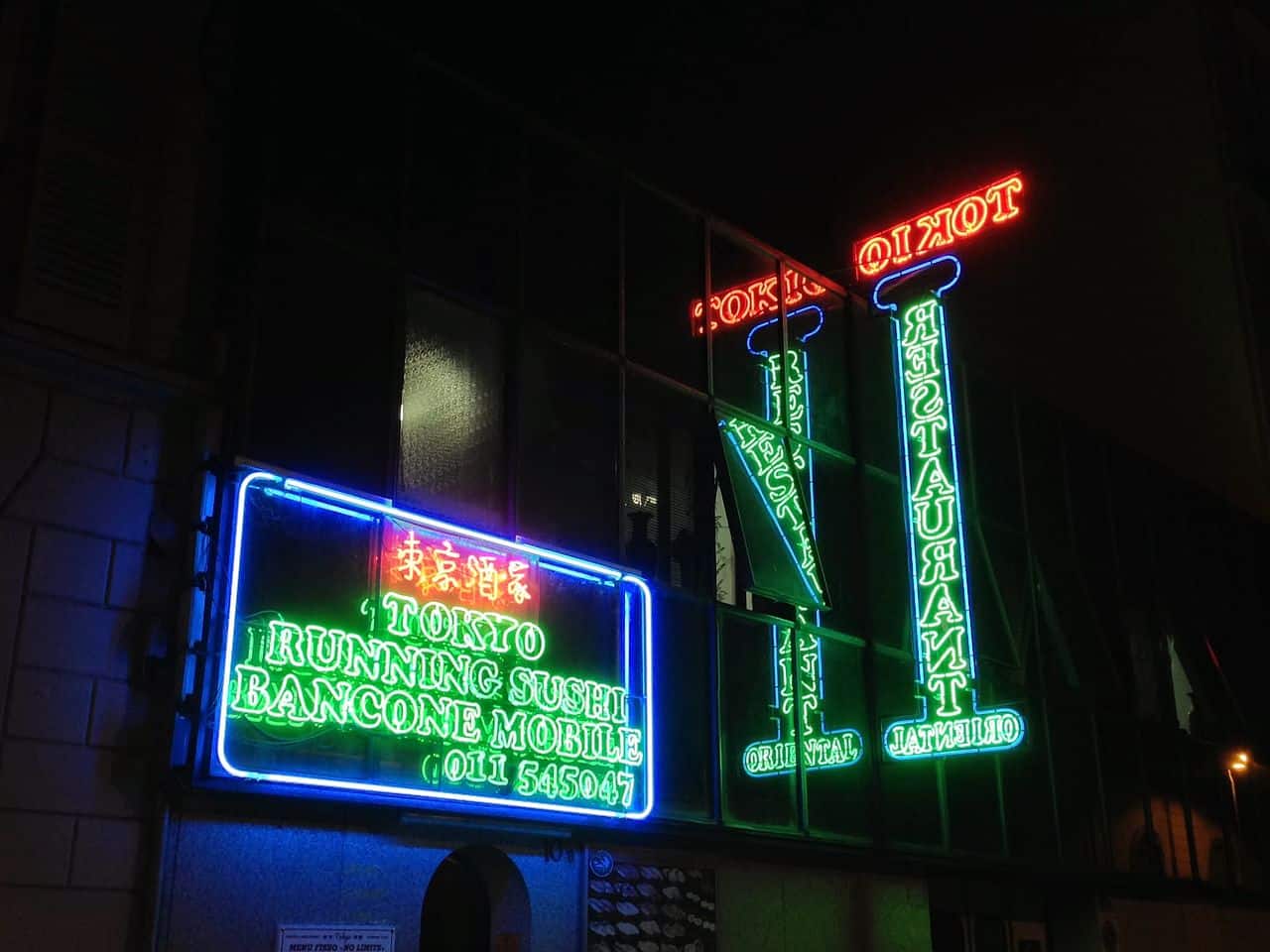
It gave Tokyo the trademark image of having entire streets filled with neon signs.
In every 12 meters of Tokyo, a vending machine is available.
These machines offer a wide variety of products like candies, sodas, and underwear. Approximately 3% of Japan’s power supplies vending machines.
The Imperial Palace was a high-priced real estate.
Measuring 1.32 square miles, Palace grounds cost higher than California’s gross real estate back when Tokyo is still in a property bubble.
The two major religions in Tokyo are Shinto and Buddhism.
Shinto traces its origins with the same age as the Japanese culture. Meanwhile, Buddhism was a mainland import since the 6th century.
The oldest temple in Japan is Tokyo Sensō-Ji Temple.

At more than 1,400 years old, the temple remains solely dedicated to the Buddhist goddess of compassion, Kannon.
World War II left the Sensō-Ji Temple in ruins.
When it was rebuilt afterward, the design was still in accordance with the original style. It then became a model of new beginnings and a symbol for the Japanese people’s resiliency.
In Tokyo, crows are one of the causes of blackouts.
These birds would often take wire coathangers as an additional foundation to their nests, which is not a good idea when they build it on power lines.
In 2010, Tokyo officials almost celebrated the triumph of a man who allegedly reached his 111th birthday.
However, upon reaching his home, they found the skeletal remains of the main on his bed instead. It turns out that he died 30 years ago, yet the family continued to take the pension money that he was supposed to receive.
No explosives or wrecking balls were involved in the disappearance of a 39-story Tokyo hotel in 2013.
Constructed in the 1980s, the Grand Prince Hotel Akasaka was set for demolition back in 2013. Authorities wanted to make the project as unnoticeable and as waste-free as possible.
The deadliest natural disaster in Japanese history is the Great Kanto Earthquake.
This massive earthquake started 30 miles south of Tokyo on September 1, 1923. With a Richter scale hit of 7.9-8.4, the shock greatly damaged Tokyo and Yokohama, taking more than 140,000 lives in its wake.
A fire tornado followed the Great Kanto Earthquake in 1923.
As if that was not enough, a tsunami as high as 40 feet fell on the city in just a few minute’s intervals.
Tokyo received a warning 60 seconds before the Tohoku Earthquake hit in 2011.
Japan has an Earthquake Early Warning (EEW) system, which also sent Sendai the same warning 10-30 seconds ahead of the hit of the major seismic waves. The push alerts came through cellphones, web pages, and TV broadcasts all over the country.
Was this page helpful?
Our commitment to delivering trustworthy and engaging content is at the heart of what we do. Each fact on our site is contributed by real users like you, bringing a wealth of diverse insights and information. To ensure the highest standards of accuracy and reliability, our dedicated editors meticulously review each submission. This process guarantees that the facts we share are not only fascinating but also credible. Trust in our commitment to quality and authenticity as you explore and learn with us.
